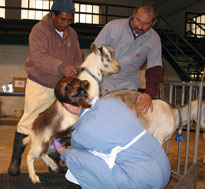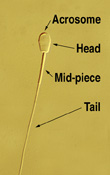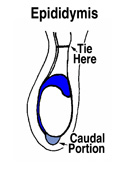The use of fresh cooled and cryogenically frozen semen in AI and ET programs is widely used in the caprine industry by the showman, hobbyist and commercial producer. Most buck semen collection occurs on location, either at the producer’s farm or a nearby fellow producer’s location. Some bucks are transported long distances to a buck stud facility where they are housed, managed, fed, and groomed for the sole purpose of improving the quality and quantity of semen produced. Traditionally, semen collected under this type of management offers the greatest viability of any product used by an AI technician. Unfortunately, the amount of semen collected under this type of management is limited due to lack of facilities that offer this type of service.
The quality of semen used in both processed fresh cooled and cryogenically frozen form is largely dependent on the overall management of the buck prior to collection. Semen viability can be greatly influenced by how frequently and recently the buck has been used for service. To increase the likelihood of obtaining semen of optimum viability for preservation, the producer should provide ideal conditions in overall management of the buck for months prior to the actual day of semen harvest.
Care of the buck
The serious producer should prepare his or her animals well in advance of the date of collection. Optimum quality in both viability and morphology of cells produced is at its highest during the cooler fall and early winter months when the buck is in the prime of “rut,” while actively and routinely servicing does. Bucks should be heavily servicing does up to five days prior to their scheduled collection date and then allowed to rest. This ensures that healthiest semen is stored and waiting in the caudal (tail) portion of the epididymis in sufficient quantities for a profitable collection. However, it is important that a producer not house the buck with a herd of does. Whether or not the does have exhibited evidence of estrous (heat) during this time is irrelevant. Bucks that have continual exposure to does may be unwilling to offer service the day of collection. When allowed to service does, bucks scheduled for an upcoming collection should be controlled on a lead rope by the producer during copulation. This helps to build confidence in the buck and prepares him for the process of collection.
Nutrition is another factor that should be taken into consideration. Breeding bucks should have a satisfactory body condition score and be put on an improved plane of nutrition as the breeding season approaches. Breeding activities and the condition of rut require tremendous amounts of energy. Bucks that are too lean often cannot produce semen of optimum quality or quantity. Overweight bucks are often lazy and less virile. Continuous, year-round, daily access to adequate volumes of water, salt, and trace minerals are vital to the buck’s fertility. These minerals are of prime importance to the donor’s production of semen with healthy motility and a high sperm count. If the producer is feeding hay from a selenium deficient area, a veterinarian should be consulted to assist in the proper method of boosting the buck’s selenium intake at least ten weeks prior to his collection. Daily supplementation or Bo-Se injections are the most common methods chosen by producers.
Semen collection and evaluation
The collection of buck semen is accomplished, most commonly, by the use of an artificial vagina (AV). To assist in the buck’s collection, a “teaser doe” (doe showing evidence of estrus) is restrained so that the donor buck becomes aroused and can mount her. Once he mounts the teaser doe, an AV is placed over the penis as it is extended. The stimulation provided by the AV’s warm water bladder, lubrication, and pressure produce an ejaculation.
Collection using a teaser doe

Collection using a teaser doe

Use of an artifical vagina
On occasion, if a buck should refuse to mount or ejaculate into the AV, it may be necessary to harvest his semen by way of electroejaculation. However, this is not the preferred method employed by most caprine semen processors. If not performed with proper technique, expertise, and the use of quality equipment, an ill-performed procedure can be extremely painful for the donor buck and the results of such methods can be less than desirable.
Once the semen sample is harvested, it is immediately and thoroughly evaluated for spermatazoa viability (live vs dead), motility (movement), and morphology (normal vs abnormal cell structure). Any abnormality is categorized as a primary, secondary, or tertiary abnormality. An overall assessment is then made as to the spermatozoa’s predicted ability to fertilize.
Additionally, the sample is scrutinized for the presence of excessive quantities of bacteria, interfering microorganisms, and leukocytes (white blood cells). Such latter findings could indicate possible infection or disease. The presence of excessive microorganisms and/or white blood cells within the sample should eliminate it from further processing, thereby avoiding any possibility of infection or disease transfer from the donor to the intended recipient.

Normal sperm cell
Freezing
Once these evaluations are completed, the sample is analyzed for sperm concentration so that a proper dilution of cells can be made for use in the straw. Processors in the United States most commonly use a 0.5 cc straw for packaging, although 0.25 cc straws are more common in the international marketplace. Properly marked straws indicate the donor buck’s permanent identification, i.e., donor name, registration number, processing company identification, date of collection, and the animal index number assigned by the individual processing company.
The semen is then subjected to the dilution process using one of several possible mediums. These mediums traditionally consist of milk or egg yolk, sugars, antibiotics, and buffers to provide a stable environment for the semen, particularly during the transport of the fresh cooled semen. Mediums used for the purpose of protecting cells intended to be frozen generally have glycerol added as a cryoprotectant. To further complicate matters, buck seminal plasma contains an enzyme which can cause coagulation when introduced to an egg-based extender. To overcome this potential problem, semen may be “washed” via centrifugation to separate the seminal plasma from the spermatozoa before further processing, egg yolk levels in the extender may be quantitatively reduced, or in some cases a diluent that utilizes skimmed milk as opposed to egg yolk may be used.
The number of spermatozoa used per dose varies according to the intended use of the straw. It is important for producers to be aware that frozen semen straws packaged for use in laparoscopic or intra-uterine AI can consist of as few as 20 million or less cells whereas straws intended for fresh vaginal AI can contain as many as 300 million spermatozoa. The recommended and US industry standard for spermatozoa packaged for frozen storage and cervical or trans-cervical AI mandates 120 million live cells in a 0.5 cc straw, pre-freeze.
Once properly diluted and packaged in straws, the cells are further subjected to a liquid nitrogen vapor and eventually submerged into a liquid nitrogen bath at -320° F (-196° C). The entire cryogenic freezing process, including preparation and collection, can take as long as 18-20 hours to produce a quality product.
Thawing and post-thaw evaluation
Proper thawing technique of frozen semen is critical to the resulting post-thaw motility assessment and to the spermatozoa’s ultimate fertilization capabilities. Since correct protocols for semen thawing are determined by the methods used in the freezing process, the producer should consult with the processor for suggested instruction on their prescribed thaw method. In the unfortunate circumstance that the processor is unavailable, a 93-95 ° F (35° C) water bath is widely used by many AI technicians with good success.
It is strongly recommended that each AI technician invest in an inexpensive, good quality microscope capable of magnifying semen cells to such a degree as to ascertain their viability (live vs dead). Depending on the quality of microscope, a minimum magnification of 100x is necessary for even the most basic observations. More experienced technicians should also assess cell motility (the way the spermatozoa move/swim) and morphology (normal or abnormal cell appearance). Technicians and producers should understand that no semen sample is entirely void of abnormalities and that freezing semen results in a 5 to 20% loss of viability due to the freezing process.
Needless to say, a processor’s scrupulous practice of sterilization and bio-security, as well as proper semen identification, is of primary importance to the producer and purchaser of any resulting semen. Bacterial contamination can be a primary factor in low conception rates and reproductive problems. In some cases, reduction of sperm motility, acrosome integrity, and sperm cell viability can all be directly related to bacterial contamination that occurred during the processing of semen for fresh or cryogenic storage. The producer is cautioned in their selection of semen purchased for his or her use. Frozen semen production is not a regulated practice in the United States. Any level of bio-security and/or quality assurance is at the sole discretion of the processor. Any judgment made in regard to semen quality is a personal opinion made by those who have handled and observed the semen. Although more common and readily available, on-farm collection can sometimes result in the processing of sub-quality semen. This can then result in a lower quality frozen product available for the producer’s use.
Lists of mobile semen processors equipped for on-site farm collection and processing, limited area processors that conduct on-farm collection, and USDA-approved isolation facilities and collection centers can be found at the end of this module. (Mention of any business or product name does not imply endorsement of those companies or products or non-endorsement of similar companies or products. Lists are intended to be a starting point for producers in their search for desired services or products.)
Postmortem semen extraction
In the event of expected or unexpected death of a buck, cells in the body can remain viable for several hours. If properly handled and prepared for shipment, the producer can often have semen extracted, postmortem, from the animal’s properly harvested testicles. The most successful recoveries are made from buck’s whose cause of death was not related to a chronic and/or debilitating disease, nor from an animal that had been routinely receiving steroids.
During spermatogenesis, spermatozoa produced in the testes are ultimately transported through the epididymis where they continue to mature, develop motility and, at least in part, their ability to fertilize oocytes. It is in the caudal portion or tail of the epididymis that immature spermatozoa are stored until the time of ejaculation. Cells found in this storehouse can be recovered, processed, and cryogenically frozen for later use in AI.
To harvest the testicles for semen extraction purposes, the following protocol has been used widely in the field with good success:
- Leave the testicles inside the scrotum whenever possible.
- Tie off as much of the ductus deferens as possible.
- Once the ductus deferens are securely tied, cut the testicles above the tie, and remove them from the body.
- The testicles should be allowed to cool slowly, if cooled too quickly the cells could be severely damaged.
- The scrotum, with the testicles inside, should be placed inside a sealed plastic bag.
- Prepare a Styrofoam or other cooler type container by first placing a layer of ice packs, on the bottom.
- A thick layer of wadded newspaper, Styrofoam peanuts, bubble wrap or other such material should then be placed over the ice packs.
- Place the sealed bag containing the scrotum and testicles in the cooler and tape it closed. Refrain from the temptation to prepare the cooling box prior to its immediate use. The time it takes to cool the cooling box containing the testicles also allows the testicles to cool slowly, preventing potential spermatozoa damage.
- Place the cooler inside a cardboard box and prepare it for delivery.
- For semen extraction, delivery should be made to the laboratory as soon as possible, either the same day or by overnight delivery.

Where to tie off the testicles for post-mortem semen extraction

How to package the scrotum containing the testicles
A list of companies offering postmortem semen extraction services is found at the end of the module.
Next
Module Home
Certification Table of Contents
Browsing Table of Contents
